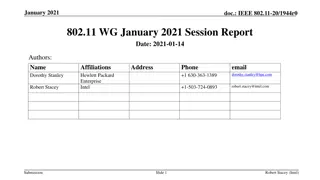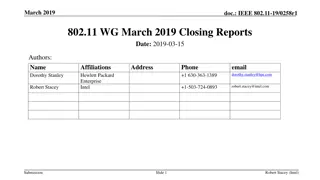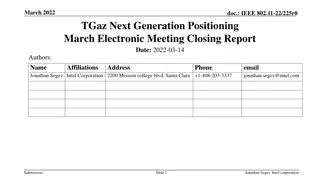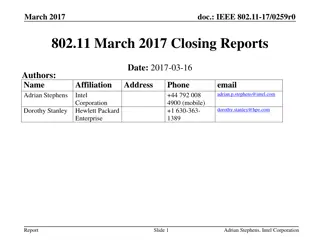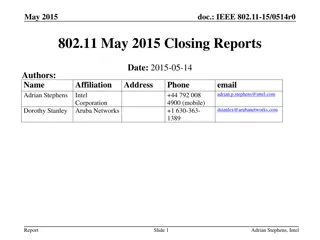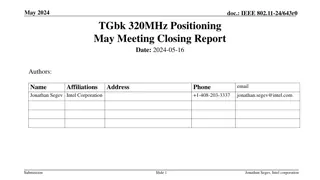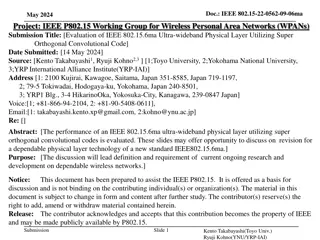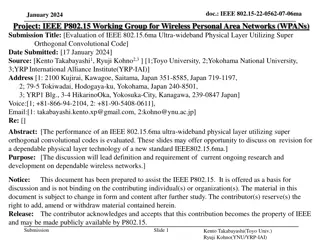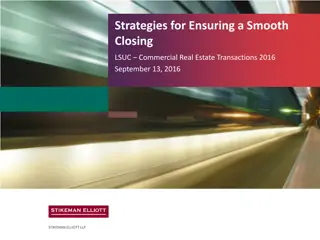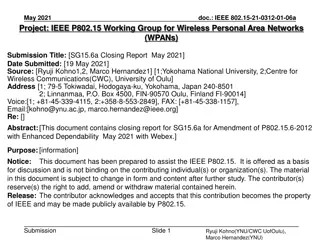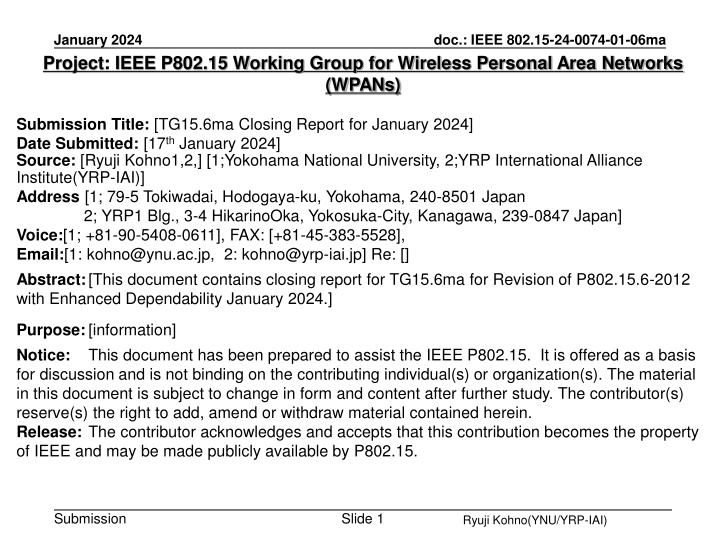
IEEE 802.15 Working Group January 2024 Closing Report
"Read about the closing report for the IEEE 802.15 Working Group's January 2024 session focusing on enhancements to Body Area Networks (BAN) and Ultra Wideband (UWB) technology for enhanced dependability in Human BAN (HBAN) and Vehicle BAN (VBAN). Learn about the objectives, interim session schedule, and next steps in the development process."
Download Presentation

Please find below an Image/Link to download the presentation.
The content on the website is provided AS IS for your information and personal use only. It may not be sold, licensed, or shared on other websites without obtaining consent from the author. If you encounter any issues during the download, it is possible that the publisher has removed the file from their server.
You are allowed to download the files provided on this website for personal or commercial use, subject to the condition that they are used lawfully. All files are the property of their respective owners.
The content on the website is provided AS IS for your information and personal use only. It may not be sold, licensed, or shared on other websites without obtaining consent from the author.
E N D
Presentation Transcript
January 2024 doc.: IEEE 802.15-24-0074-01-06ma Project: IEEE P802.15 Working Group for Wireless Personal Area Networks (WPANs) Submission Title: [TG15.6ma Closing Report for January 2024] Date Submitted: [17th January 2024] Source: [Ryuji Kohno1,2,] [1;Yokohama National University, 2;YRP International Alliance Institute(YRP-IAI)] Address [1; 79-5 Tokiwadai, Hodogaya-ku, Yokohama, 240-8501 Japan 2; YRP1 Blg., 3-4 HikarinoOka, Yokosuka-City, Kanagawa, 239-0847 Japan] Voice:[1; +81-90-5408-0611], FAX: [+81-45-383-5528], Email:[1: kohno@ynu.ac.jp, 2: kohno@yrp-iai.jp] Re: [] Abstract: [This document contains closing report for TG15.6ma for Revision of P802.15.6-2012 with Enhanced Dependability January 2024.] Purpose: [information] Notice: This document has been prepared to assist the IEEE P802.15. It is offered as a basis for discussion and is not binding on the contributing individual(s) or organization(s). The material in this document is subject to change in form and content after further study. The contributor(s) reserve(s) the right to add, amend or withdraw material contained herein. Release: The contributor acknowledges and accepts that this contribution becomes the property of IEEE and may be made publicly available by P802.15. Submission Slide 1 Ryuji Kohno(YNU/YRP-IAI)
January 2024 doc.: IEEE 802.15-24-0074-01-06ma IEEE 802.15 TG6ma (Revision of IEEE802.15.6-2012) Closing Report In Personal and Virtual Hybrid Interim Session Panama January 18th, 2024 Ryuji Kohno Yokohama National University(YNU), YRP International Alliance Institute(YRP-IAI) Submission Slide 2 Ryuji Kohno(YNU/YRP-IAI)
January 2024 doc.: IEEE 802.15-24-0074-01-06ma 1. Objectives of TG 6ma Enhanced Dependability Body Area Network (ED-BAN) Objective: Enhancements to the BAN Ultra Wideband (UWB) physical layer (PHY) and media access control (MAC) to support enhanced dependability to a human BAN (HBAN) and adds support for vehicle body area networks (VBAN), a coordinator in a vehicle with devices around the vehicular cabin. Action: Update draft#1.11 of Draft Proposals for Pre-Ballot Comment resolution for draft#1.11 Performance Evaluation of Technologies in PHY; Channel Coding According to 8 QoS Levels of Packets and Coexistence Levels, Interference Mitigation, etc. Performance Evaluation of Technologies in MAC; Channel Management, CCA, Hybrid Contention Free/Access Protocol According to 8 QoSs and Coexistences. Harmonization or Commonality with 4ab in Coexistence and Feasible Implementation of 6ma and 4ab Feasibility of TSN of 802.1 in MAC Next Things to Do Finalize draft#1 for Letter Ballot Slide 3 Submission Ryuji Kohno(YNU/YRP-IAI)
January 2024 doc.: IEEE 802.15-24-0074-01-06ma 17th th, Jan. 2024 2. TG15.6ma Interim Session Schedule for 14 2. TG15.6ma Interim Session Schedule for 14- -17 , Jan. 2024 TG15.6ma has three own sessions such as Session1(Virtual RM#2) AM2 10:30-12:30 Jan. 15(MON) in Panama time, 0:30 - 2:30 Jan. 16(TUE) in JST/KST Session2(Virtual RM#2) AM1 8:00-10:00 Jan. 16(TUE) in Panama time, 22:00-24:00 Jan. 16(TUE) in JST/KST Session3(Virtual RM#2) AM1 9:00-10:00 Jan. 17(WED) in Panama time, 23:00-24:00 Jan. 17(WED)in JST/KST Session4(Virtual RM#2) AM1 8:00-10:00 Jan. 18(THU) in Panama time, 22:00-24:00 Jan. 16(TUE) in JST/KST Submission Slide 4 Ryuji Kohno(YNU/YRP-IAI)
January 2024 doc.: IEEE 802.15-24-0074-01-06ma 3. Agenda items for the week TG15.6ma meeting call to order TG15.6ma Opening Information for January 2024 doc.#15-23-0638-01-06ma Approve last meeting minutes: TG 15.6ma Meeting Minutes for November 2023 doc.#15-23-0608-00-06ma Agenda of TG15.6ma January 2024 Meeting doc.#15-23-0636-08-06ma Review and Summary 1. Basic Consensus in MAC and PHY of Revision of IEEE802.15.6-2012(IEEE802.15.6ma) doc.#15-23-0557-01-06ma 2. Progress and Action Items for Draft#1 doc.#15-23-0360-03-06ma 3. Draft pre-ballot comment resolution doc.#15-23-0476-11-06ma 4. Rescheduling Timeline doc.#15-23-0361-03-06ma Presentation 1. MAC superframe structure for coexisting multiple dependable BANs doc.#15-24-0013-01-06ma 2. MAC frame formats based on harmonization agreements doc.#15-24-0054-00-06ma 3. Progress and Action Items for Draft#1 (Draft#1.19) doc.#15-23-0360-03-06ma 4. Draft PAR and CSD 802.1ACea: Amendment to IEEE Standard 802.1AC-2016 doc.#15-23-0453-01&454-01-06ma 5. Resolution Database for Pre-Ballot WG doc.#15-23-0476-01-06ma 6. Hybrid ARQ Scheme for High QoS Packets in High Class of Coexistence of IEEE 802.15.6ma 0576-01-06ma 7. Preliminary Evaluation on Ranging Accuracy with Interference Cancellation in Coexistence Environments 24-057-00 8. Evaluation of IEEE 802.15.6 Ultra-wideband Physical Layer Utilizing Super Orthogonal Convolutional Code 6. Simulation results for Nagoya I. T. and YRP-IAI MAC proposal Based on TG6ma Channel Model -0352-03-06ma 7. UWB Positioning in 15.6ma for Multiple BAN Adjacent Scenarios doc.#15-23-0560-01-06ma 8. Performance Evaluation of Channel Coding under Various Channel Models in Some Classes of Coexistence in TG6ma 10. Interference Mitigation Schemes in Class 3, 5, 6, and 7 of Coexisitence in TG6ma 11 TG6ma Channel Model Document for Enhanced Dependability doc.#15-22-0519-05-06ma 13. Overview and convergence of MAC proposals for 15.6ma doc.#15-24-0078-00-06ma 14. Progress Report of TG6ma doc.#15-23-0056-06-06ma 15. Timeline of TG6ma 16. TG15.6ma Closing Report for January 2024 doc.#15-24-0074-00-06ma 17. TG15.6ma Meeting Minutes for January 2024 doc.#15-24-0075-00-06ma doc.#15-24-0051-00-06ma doc.#15-23-0577-01-06ma doc.#15-24-0073-00-06ma doc.#15.23-0407-03-06ma Submission Slide 5 Ryuji Kohno(YNU/YRP-IAI)
January 2024 doc.: IEEE 802.15-24-0074-01-06ma 4. Basic Agreement(1/2) IEEE802.15.6ma; revision of IEEE802.15.6-2012 focuses on enhanced dependability in data transmission and ranging in classified environments of coexistence with the same and other frequency shared wireless networks. 15.6ma covers new and conventional channel models of major use cases of 802.15.6ma Body Area Networks (BAN) are for human and vehicle bodies in medical and automotive applications for enhanced dependability. 15.6ma supports some backward compatibility with 15.6- 2012 as much as possible but not all of them in PHY and MAC. 15.6ma aims to replace 15.6-2012 for enhanced dependability. For instance, 15.6ma focuses on only UWB in PHY and only time structure mode in MAC. Submission Slide 6 Ryuji Kohno(YNU/YRP-IAI)
January 2024 doc.: IEEE 802.15-24-0074-01-06ma 4. Basic Agreement(2/2) In order to perform enhaced dependability in revision of IEEE802.15.6-2012(IEEE802.15.6ma), coexistence environments have been classified. Some classes of multiple new and legacy BANs coexistence are focused to manage packet contention in MAC layer while other classes are taken care by mitigation of interference in Physical layer(PHY) and manage contention in MAC. Ranging in 802.15.6ma is optional but ranging between coordinators of neibouring or coverage overlaid BANs is helpful to identify geographical overlay and mobility of incoming and outgoing to determine coexistence class stataes. Ranging between BAN coordinator and its nodes in star topology in 802.15.6ma is the same as 802.15.4z and its amendment. Submission Slide 7 Ryuji Kohno(YNU/YRP-IAI)
January 2024 doc.: IEEE 802.15-24-0074-01-06ma 5. 15.6ma PHY and MAC New Features(1/2) Since IEEE802.15.6-2012 has too many modes in PHY and MAC, 15.6ma chooses a few modes to simplify specification of PHY and MAC while introduces new error-controlling schemes of FEC and HARQ, and management and data channels for enhanced dependability in various channel models and 8 classes of coexistence models for 8 levels of QoS priority order packets such as 1. PHY Various channel coding and decoding matched with QoS priority levels of packets and coexistence classes Interference mitigation schemes according to various environment of coexistence classes 2. MAC Two channels using two UWB band channels are applied for management channel to control frames of coexisting networks and data transmission channel. Its alternative mode is two channels for management and data transmission using a single UWB band channel. Coordinator-to-coordinator(C2C) negotiation of existing networks 3. Cross Layer of PHY and MAC Hybrid ARQ for higher priority of packets in high class of coexistence Submission Slide 8 Ryuji Kohno(YNU/YRP-IAI)
January 2024 doc.: IEEE 802.15-24-0074-01-06ma 5. 15.6ma PHY and MAC New Features(2/2) 3. Cross Layer of PHY and MAC Hybrid ARQ for higher priority of packets in high class of coexistence For the sake of easy implementation, hybrid ARQ is optional in limited high classes of coexistene. Ranging between coexisting BANs coordinators could be proceeded by C2C(coordinator-to-coordinator) functionality. Ranging information in PHY is applied for identifying coexistence class states in which appropriate MAC is selected. Submission Slide 9 Ryuji Kohno(YNU/YRP-IAI)
January 2024 doc.: IEEE 802.15-24-0074-01-06ma 6.1 Definition of Coexistence Environment Classes Coexisting system(s) Coexist ence Class Non-802.15 UWB (ex. ETSI SmartBAN) - Non-UWB (ex. Wi-Fi / Unlicensed / 3GPP) 802.15 UWB (ex. 802.15.4) Category 802.15.6- 2012 802.15.6ma 0 - - - - Single BAN 1 (1a) - - - - Multiple 15.6 BANs 2 (1b) - - - 3 - - - Non-UWB 4 (2a) - - - Multiple UWB systems 5 (2b) - - - 6 (2c) - - 7 Final Boss The coexistence class has been redefied to 8 levels, which can be represented by 3 bits and would be suitable to include in PHY or MAC headers. Submission Slide 10 Ryuji Kohno(YNU/YRP-IAI)
January 2024 doc.: IEEE 802.15-24-0074-01-06ma 6.2 Coexistence Class States Transition(1/2) The standard's revision supports BANs operating with high reliability (coexistence class 0) and coexisting in dense environments with intra-interference and inter-interference (coexistence class 1 to 7). Figure 6 shows the state transition between several classes of coexistence environments defined in above mentioned table. Class 0: 6ma BAN alone Class 1: Multiple 6ms BANs Class 2: 6ma BAN with old 6 BAN Class 4: 6ma BAN with other 802.15 UWB WSNs e.x. 4z, 4ab Class 3: 6ma BAN with other narrowband Nets WSNs Class 5: 6ma BAN with other UWB Nets e.x. ESTI SmartBAN Class 6: 6ma with 802.15 other WSN Class 7: 6ma with any frequency shared networks Figure 6 Diagram of state transitions for coexistence class environments. Submission Slide 11 Ryuji Kohno(YNU/YRP-IAI)
January 2024 6.2 Coexistence Class States Transition(2/2) doc.: IEEE 802.15-24-0074-01-06ma The standard's revision focuses on the dependability mechanisms for a single HBAN or VBAN (Class 0) and the scenario with multiple HBANs or VBANS (Class 1). Class 2 supports compatibility with legacy BANs (IEEE 802.15.6-2012 Std). Class 4 supports coexistence with other IEEE 802.15 UWB Stds, and amendments such as 15.4, 15.8, 15.4z, and 4ab, via the PHY and MAC specification. Classes 3, 5, 6, and 7 support coexistence with other wireless systems can result in Class 0, 1, and 2 by mitigation technology to cancel interference from other radios except regacy 15.6 at the receiver side (see clause 4.7.2 of draft#1.11. During CCA, a BAN coordinator may analyze the type of synchronization preamble detected from a 15.6ma, 15.6, or 15.4 system. In Figure 6, the state transition probabilities are approximated in consecutive superframes. Furthermore, the duration of the CAP and CFP are determined by statistics of various QoS level of packets in previous consecutive superframes for every coming superframe. The draft revision #1.11 supports BANs operating with high reliability in dense environments coexisting with intra-interference and inter-interference due to other wireless systems in the same frequency band. Figure 6 shows state transition among several classes of coexistence environment defined in Table 1. Submission Slide 12 Ryuji Kohno(YNU/YRP-IAI)
January 2024 doc.: IEEE 802.15-24-0074-01-06ma 6.3 QoS Levels of Packets corresponding to User Priority In Std.15.6 WBAN systems, a various data such as vital signs, skin temperature, blood pressure, ECG, EEG, ECoG, and vehicle controlling commons have different QoS levels corresponding to user priority. User priority Traffic designation Frame type 0 Background (BK) Data 1 Best effort (BE) Data 2 Excellent effort (EE) Data In 15.6ma for dependable WBAN for human and vehicles, data packet transmission should be dependable according to QoS levels even in various classes of coexistence environment. 3 Video (VI) Data 4 Voice (VO) Data 5 Medical data or network control Data or management 6 High-priority medical data or network control Data or management Therefore, appropriate sets of error controlling scheme with FEC and hybrid ARQ corresponding to QoS levels have been standardized in 15.6ma, 7 Emergency or medical implant event report Data Submission Slide 13 Ryuji Kohno(YNU/YRP-IAI)
January 2024 doc.: IEEE 802.15-24-0074-01-06ma 6.4 FEC/HARQ for 64 Combinations of 8 Coexistence Classes 8 QoS Packet Levels FEC codes and Hybrid ARQ have been designed for 8 8 = 64 combinations for QoS levels and Coexistence classes under various standard of channel models. Submission Slide 14 Ryuji Kohno(YNU/YRP-IAI)
January 2024 doc.: IEEE 802.15-24-0074-01-06ma Error-correcting codes corresponding to QoS levels Common with IEEE802.15.4ab Channel Coding Table #1 User priority Inner code Outer code HARQ 0 15.4ab LDPC code (R=1/2) - 1 15.4ab LDPC code (R=1/2) - 2 15.4ab LDPC code (R=1/2) - 3 15.4ab LDPC code (R=1/2) - 4 15.4ab LDPC code (R=1/2) (54, 46) shortened RS code - 5 15.4ab LDPC code (R=1/2) (54, 38) shortened RS code - 6 15.4ab LDPC code (R=1/2) (54, 28) shortened RS code - 7 15.4ab LDPC code (R=1/2) (54, 14) shortened RS code - As an outer code, shortened Reed-Solomon (RS) codes with N=54 (original code length N=63) will be selected to correct burst errors due to interference from other WBANs and the coding rates are changed according to each QoS and channel condition As an inner code, 15.4ab LDPC codes (K=324, 648, 972, R=1/2) will be selected for the coexistence of 15.6ma and 15.4ab This updated concept table is considered as the first priority Submission Slide 15 Ryuji Kohno(YNU/YRP-IAI)
January 2024 doc.: IEEE 802.15-24-0074-01-06ma TG 6ma Timeline(expected) EC approv al to SB, SB submis sion May 2024 Comme nts and resoluti on for pre- ballot. Nov 2023 Revc om Appr ove Sept 2024 SB recircul ation if required July 2024 Finalize Std Draft V1 Presenta tion of proposal sNov202 2 Jan.2023 Std Draft Tech Req Doc(TR D) July 2022 V0 May 2023 August 2023 WG pre- ballot Sept 2023 Upload preliminary draft v1 on WG repository to revise for finalizing v1 July2023 Revcom Submissi on Aug. 2024 Harmoni zation of Proposal s Mar 2023 SB TRD,CM D Call Proposals Sept 2022 WG letter ballot (LB) Jan. 2024 recircul ation June 2024 Notes: SASB/RevCom scheduled for 2024 a guess Submission Slide 16 Ryuji Kohno(YNU/YRP-IAI)
January 2024 doc.: IEEE 802.15-24-0074-01-06ma Expecting Timeline detail Note: the deadlines are subject to change. Submission Slide 17 Ryuji Kohno(YNU/YRP-IAI)
January 2024 doc.: IEEE 802.15-24-0074-01-06ma Contributions TG15.6ma opening report for January 2024 meeting 15-23-0638-01-06ma TG15.6ma Agenda of January Meeting in 2024 15-23-0636-08-06ma Progress and Action Items for Draft#1 15-23-0360-03-06ma Draft pre-ballot comment resolution 15-23-0476-10-06ma Rescheduling Timeline 15-23-0361-02-06ma Basic Consensus in MAC and PHY of Revision of IEEE802.15.6-2012 15-23-0557-01-06ma MAC superframe structure for coexisting multiple dependable BANs 15-24-0013-01-06ma MAC frame formats based on harmonization agreements 15-24-0054-00-06ma Preliminary Evaluation on Ranging Accuracy with Interference Cancellation in Coexistence Environments 15-24-0057-00-06ma Evaluation of IEEE 802.15.6 Ultra-wideband Physical Layer Utilizing Super Orthogonal Convolutional Code 15-24-0051-00-06ma Simulation results for Nagoya I. T. and YRP-IAI MAC proposal 15-23-0242-03-06ma Hybrid ARQ Scheme for High QoS Packets in High Class of Coexistence of IEEE 802.15.6ma 0474-01-06ma Evaluation of IEEE 802.15.6 Ultra-wideband Physical Layer Utilizing Super Orthogonal Convolutional Code Preliminary performance evaluation of ranging in coexistence environment 15-23-0353-04-06ma Performance Evaluation of Channel Coding under Various Channel Models in Some Classes of Coexistence in TG6ma TG6ma Channel Model Document for Enhanced Dependability 15-22-0519-05-06ma Draft pre-ballot comment resolution 15-23-0476-13-06ma Interference Mitigation Schemes in Class 3, 5, 6, and 7 of Coexisitence in TG6ma Overview and convergence of MAC proposals for 15.6ma 15-24-0078-00-06ma Progress Report of TG6ma 15-23-0056-05-06ma TG15.6ma closing report for January 2024 meeting 15-24-0074-00-06ma TG15.6ma January 2024 meeting minutes 15-24-0075-00-06ma / Slide 18 15-22-0562-05-06ma 15-23-0577-00-06ma 15-24-0073-00-06ma Submission Ryuji Kohno(YNU/YRP-IAI)
doc.: IEEE 802.15-24-0074-01-06ma January 2024 Contacts and Conference call 1. kohno@ynu.ac.jp, kohno@yrp-iai.jp 2. 1st Vice-Chair; Marco Hernandez, YRP-IAI/CWC marco.hernandez@ieee.org 2nd Vice-Chair; Daisuke Anzai, NIT anzai@nitech.ac.jp 3. Secretary; Takumi Kobayashi, YNU/TCU kobayashi-takumi@yrp-iai.jp, kobayashi@nitech.ac.jp 4. Technical Editors; Minsoo Kim, YRP-IAI minsoo@minsookim.com Seong-Soon Joo, KPST wowbk@kpst.co.kr Kento Takabayashi, Toyo U. takabayashi.kento.xp@gmail.com Marco Hernandez, YRP-IAI/CWC marco.hernandez@ie ee.org Jussi Haapola, CWC jussi.haapola@oulu.fi Slide 19 Chair; Ryuji Kohno, YNU/YRP-IAI Submission Ryuji Kohno(YNU/YRP-IAI)
January 2024 doc.: IEEE 802.15-24-0074-01-06ma Thank You ! Any Questions ? Slide 20 Submission Ryuji Kohno(YNU/YRP-IAI)



